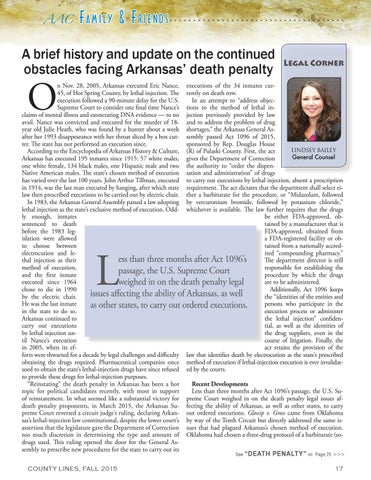AAC
Family & Friends
» » » » » » » » » » » » » » » » » » » » » » » » » » » » » » » » » » » » »
A brief history and update on the continued obstacles facing Arkansas’ death penalty
Legal Corner
O
n Nov. 28, 2005, Arkansas executed Eric Nance, executions of the 34 inmates cur45, of Hot Spring County, by lethal injection. The rently on death row. execution followed a 90-minute delay for the U.S. In an attempt to “address objecSupreme Court to consider one final time Nance’s tions to the method of lethal inclaims of mental illness and exonerating DNA evidence — to no jection previously provided by law avail. Nance was convicted and executed for the murder of 18- and to address the problem of drug year old Julie Heath, who was found by a hunter about a week shortages,” the Arkansas General Asafter her 1993 disappearance with her throat sliced by a box cut- sembly passed Act 1096 of 2015, ter. The state has not performed an execution since. sponsored by Rep. Douglas House LINDSEY BAILEY According to the Encyclopedia of Arkansas History & Culture, (R) of Pulaski County. First, the act General Counsel Arkansas has executed 195 inmates since 1915: 57 white males, gives the Department of Correction one white female, 134 black males, one Hispanic male and two the authority to “order the dispenNative American males. The state’s chosen method of execution sation and administration” of drugs has varied over the last 100 years. John Arthur Tillman, executed to carry out executions by lethal injection, absent a prescription in 1914, was the last man executed by hanging, after which state requirement. The act dictates that the department shall select eilaw then prescribed executions to be carried out by electric chair. ther a barbiturate for the procedure, or “Midazolam, followed In 1983, the Arkansas General Assembly passed a law adopting by vercuronium bromide, followed by potassium chloride,” lethal injection as the state’s exclusive method of execution. Odd- whichever is available. The law further requires that the drugs ly enough, inmates be either FDA-approved, obsentenced to death tained by a manufacturer that is before the 1983 legFDA-approved, obtained from islation were allowed a FDA-registered facility or obto choose between tained from a nationally accredelectrocution and leited “compounding pharmacy.” ess than three months after Act 1096’s thal injection as their The department director is still method of execution, responsible for establishing the passage, the U.S. Supreme Court and the first inmate procedure by which the drugs executed since 1964 are to be administered. weighed in on the death penalty legal chose to die in 1990 Additionally, Act 1096 keeps issues affecting the ability of Arkansas, as well by the electric chair. the “identities of the entities and He was the last inmate persons who participate in the as other states, to carry out ordered executions. in the state to do so. execution process or administer Arkansas continued to the lethal injection” confidencarry out executions tial, as well as the identities of by lethal injection unthe drug suppliers, even in the til Nance’s execution course of litigation. Finally, the in 2005, when its efact retains the provision of the forts were thwarted for a decade by legal challenges and difficulty law that identifies death by electrocution as the state’s prescribed obtaining the drugs required. Pharmaceutical companies once method of execution if lethal-injection execution is ever invalidatused to obtain the state’s lethal-injection drugs have since refused ed by the courts. to provide these drugs for lethal-injection purposes. “Reinstating” the death penalty in Arkansas has been a hot Recent Developments topic for political candidates recently, with most in support Less than three months after Act 1096’s passage, the U.S. Suof reinstatement. In what seemed like a substantial victory for preme Court weighed in on the death penalty legal issues afdeath penalty proponents, in March 2015, the Arkansas Su- fecting the ability of Arkansas, as well as other states, to carry preme Court reversed a circuit judge’s ruling, declaring Arkan- out ordered executions. Glossip v. Gross came from Oklahoma sas’s lethal-injection law constitutional, despite the lower court’s by way of the Tenth Circuit but directly addressed the same isassertion that the legislature gave the Department of Correction sues that had plagued Arkansas’s chosen method of execution. too much discretion in determining the type and amount of Oklahoma had chosen a three-drug protocol of a barbiturate (sodrugs used. This ruling opened the door for the General Assembly to prescribe new procedures for the state to carry out its See “DEATH PENALTY” on Page 25 > > >
L
COUNTY LINES, FALL 2015
17
